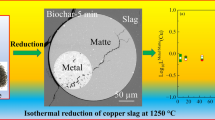Abstract
In recent decades, the use of metal sulfides instead of hydroxide precipitation in hydrometallurgical processes has gained prominence. Some arguments for its preferential use are as follows: a high degree of metal removal at relatively low pH values, the sparingly soluble nature of sulfide precipitates, favorable dewatering characteristics, and the stability of the formed metal sulfides. The Merrill–Crowe zinc-precipitation process has been applied worldwide in a large number of operations for the recovery of gold and silver from cyanide solutions. However, in some larger plants, the quality of this precious precipitate is low because copper, zinc and especially lead are precipitated along with gold and silver. This results in higher consumption of zinc dust and flux during the smelting of the precipitate, the formation of the matte, and a shorter crucible life. The results show that pH has a significant effect on the removal efficiency of zinc and copper cyanide ions. The optimal pH range was determined to be 3–4, and the removal efficiency of zinc and copper cyanide ions was up to 99%.





Similar content being viewed by others
References
J.R. Parga, J.L. Valenzuela, and F. Cepeda, JOM 10, 43 (2007).
I. Rehman and W. Bonfield, J. Mater. Sci. Mater. Med. 8, 1 (1997).
S. Rayanaud, E. Champion, D. Bernache-Assollant, and P. Thomas, Mater. Chem. Phys. 23, 1065 (2002).
W. Lin, R.C. Viadero, B.E. Reed, and R.L. Vaughan, Water Environ. Res. 71, 816 (1999).
R.W.Peters, Y. Ku, and. D. Bhattacharyya, in AIChE Symp. Series, vol. 81 (1985) pp. 165–172.
I.A.Sultan, Environ. Tech., (1998) pp. 56–60
F. Fenglian and Q. Wang, J. Environ. Manag. 92, 407 (2011).
Freedman and Shannon, in Industrial Water Enginnering (1973) pp. 31.
A. Özverdi and M.J. Erdem, Hazard. Mater. 137, 626 (2006).
A.E. Lewis, Hydrometallurgy 104, 222 (2010).
H.M. Freeman, Standard Handbook of Hazardous Waste Treatment and Disposal (New York: McGraw-Hill, 1989), p. 7.21.
K.A. Baltpurvins, R.C. Burns, G.A. Lawrance, and A.D. Stuart, Effect of electrolyte composition on zinc hydroxide precipitation by lime. Water Res. 31, 973–980 (1997).
Acknowledgements
The authors gratefully acknowledge the National Council of Science and Technology (CONACYT), the Department of Chemical Engineering and Metallurgical at the University of Sonora, and TNM (ITS) in Mexico.
Author information
Authors and Affiliations
Corresponding author
Rights and permissions
About this article
Cite this article
Figueroa, G.V., Parga, J.R., Valenzuela, J.L. et al. An Improved Process for Precipitating Cyanide Ions from the Barren Solution at Different pHs. JOM 68, 540–547 (2016). https://doi.org/10.1007/s11837-015-1746-4
Received:
Accepted:
Published:
Issue Date:
DOI: https://doi.org/10.1007/s11837-015-1746-4




